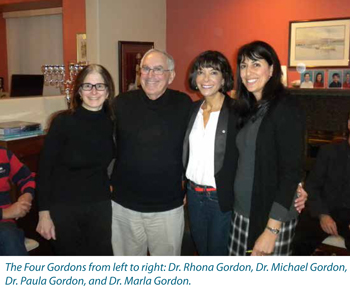A Strange Looking Rash That Does Not Respond to Topical Corticosteroids
A Strange Looking Rash That Does Not Respond to Topical Corticosteroids
Members of the College of Family Physicians of Canada may claim one non-certified credit per hour for this non-certified educational program.
Mainpro+® Overview
The Four Dr. Gordons: Connecting the Past with the Present
I have for many years enjoyed my family name, Gordon, and all the connections I can make with it. I learned when I was quite young, from my paternal grandfather that the name had been ours for many generations and had not been changed as had those of my childhood friends. I had stored that knowledge deep into the recesses of my memory. When I decide to study medicine in Scotland, the name became a talking point, as everyone assumed that with that name I must in fact have Scottish ancestry. I could only explain that the name was genuine, unsullied by arbitrary or deliberate alteration by American immigration authorities when my grandfather arrived from a small village in Lithuania.
It was only some years later, during my first trip to Israel that I read a history of Russia by a Scottish historian. There I found a reference to the likely origin of the Jewish Lithuanian and by dint of migration Russian Gordons. It was Peter the Great's desire for territorial expansion that led him to hire a militarily brilliant Scottish mercenary general by the name of Patrick Gordon. It was General Gordon, who successful in many Russian expansionist battles ultimately became a close friend and confidant of the Tsar. A well detailed biography of Peter the Great by Robert Massie explains how Gordon's death was mourned by the Tsar as a loss to his empire. During the later emancipation process, when Russians adopted family names, it appears that my ancestors, in deference and regard to the Tsar's great friend took on the name Gordon. Although there are varying iterations on the origins of that name in Jewish Russian/Lithuanian history, this narrative has always seemed to me to be the most credible.
During the pogrom-dominated anti-Jewish period in Russia around the turn of the 20th century many Jews left Russia, including my ancestral village of Eysheshuk I near Vilna and made their way to the United States, then British Palestine and South Africa. When I was sitting my oral examination in Midwifery in Dundee Scotland, then still part of the University of St. Andrews, my examiner was the "prof" (professor and head of the department) himself. As I sat down he said, "You're the Yank" in his mellifluous Scottish dialect which by this time had become music to my Brooklyn English ears. "Surely" he continued, "with a name like Gordon, you must be Scottish." I responded with a "yes and no, but if you would like to hear the story, I would be happy to tell you." He nodded yes and with my eye on the clock above his head, ticking out the 10 minutes of oral examination time, I recounted the tale. With 30 seconds left, he interrupted with "Oh dear, Oh dear, we're running out of time, followed by 'give me three symptoms or signs of eclampsia'". I knew the answer "cold" as it was one we all prepared for knowing how important the subject was. As I turned to leave the room I saw him write a 10 and say, "very good, very good" in broad Scottish.

That event resulted in a prize in midwifery much to the shock and surprise of my classmates as it was not my "strong" subject. With the 500 pounds I spent 5 months doing midwifery and gynaecology at the Rambam Hospital in Haifa, which resulted in epiphany in my life which circuitously resulted in Aliyah some years later. My return to North America and settlement in Canada is complex but I have always responded to the name Gordon with the question to determine if the person was perhaps a landsman and if they are aware of the history of the name. This has resulted in many warm interactions and sharing of family histories.
This was personified on a recent invitation to Vancouver to attend a conference as a presenter. After the acceptance I received a request to attend a meeting of the newly established Vancouver chapter of the Israel Medical Association, having been involved in the Toronto chapter for many years. Once accepted I received an email form Dr. Paula Gordon, a Vancouver radiologist who trained at Mt. Sinai Hospital early on in my career as a clinical teacher.
At the IMA meeting, Dr. Marla Gordon, an elder-care focused primary care physician at whose house we were meeting introduced herself and reminded me that years earlier she had asked me via-email about my knowledge of the derivation of our name. Also at the meeting was Dr. Rhona Gordon, a family physician with a major focus in Obstetrics and newborn care, is married to the president of the Vancouver IMA. We spent much of the post-meeting time comparing our family histories and our understandings of the movements through Europe and North America of our respective Gordon families. We concluded the we were for sure Landsman (a Yiddish term for people of the same geographic area—which in 18th and 19th century Eastern Europe usually meant the same village or district. I could add these three to other Gordons living in Israel who also I knew as émigrés from Eyshoshuk or other parts of Lithuania.
This experience reminded me of the importance of keeping people with cognitive impairment as grounded as possible with ideas, events, people and associations that they can relate to and which are meaningful. The use of photographs is very important in helping those living with dementia relate to important people and events in their life. The nice thing about the use of photographs is that they can be shown and discussed time after time without the person getting bored as they may have little recollection of having looked at the pictures recently. (/article/photography-many-windows-memories). It has been shown that familiar and personal music is also useful to those living with dementia and the fact that the person can related to their music has been demonstrated to bring back important memories that may result in revitalization of the person even within the context of dementia and may also be useful when dealing with behavioural issues such as agitation (http://www.youtube.com/watch?v=Fw7Y78aqf_I).
What could be defined and an expansion of one's historical connections also resulted in a recognition of the importance of individual roots and relationships. As physicians dealing with dementia we should also try and explore and find those aspects of our patient's lives and experiences with which they can connect, and if we can add to or enhance that connection, all the better for a fulfilling and meaningful and ultimately more successful clinical experience—for the patient and for the physician.
Post-test: Spinal Cord Stimulation
Members of the College of Family Physicians of Canada may claim MAINPRO-M2 Credits for this unaccredited educational program.
| Questions | 5 |
|---|---|
| Attempts allowed | Unlimited |
| Available | Always |
| Backwards navigation | Forbidden |
Pre-test: Spinal Cord Stimulation
| Questions | 3 |
|---|---|
| Attempts allowed | Unlimited |
| Available | Always |
| Backwards navigation | Forbidden |
Editor's Note, Volume 4 Issue 1
Editor's Note, Volume 4 Issue 1
D’Arcy Little, MD, CCFP, FRCPC
Medical Director, JCCC and HealthPlexus.NET

- Read more about Editor's Note, Volume 4 Issue 1
- Log in or register to post comments
Post-test: Large Nasal Vestibular Mass
Members of the College of Family Physicians of Canada may claim MAINPRO-M2 Credits for this unaccredited educational program.
| Questions | 4 |
|---|---|
| Attempts allowed | Unlimited |
| Available | Always |
| Backwards navigation | Forbidden |
Pre-test: Large Nasal Vestibular Mass
| Questions | 2 |
|---|---|
| Attempts allowed | Unlimited |
| Available | Always |
| Backwards navigation | Forbidden |
Post-test: Tinea incognito
Members of the College of Family Physicians of Canada may claim MAINPRO-M2 Credits for this unaccredited educational program.
| Questions | 5 |
|---|---|
| Attempts allowed | Unlimited |
| Available | Always |
| Backwards navigation | Forbidden |
Pre-test: Tinea incognito
| Questions | 3 |
|---|---|
| Attempts allowed | Unlimited |
| Available | Always |
| Backwards navigation | Forbidden |

 Michael Gordon, MD, MSc, FRCPC, Medical Program Director, Palliative Care, Baycrest Geriatric Health Care System, Professor of Medicine, University of Toronto, Toronto, ON.
Michael Gordon, MD, MSc, FRCPC, Medical Program Director, Palliative Care, Baycrest Geriatric Health Care System, Professor of Medicine, University of Toronto, Toronto, ON.